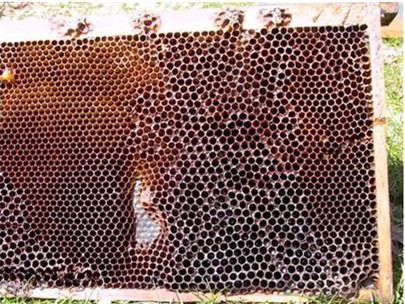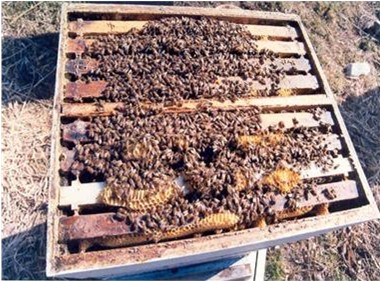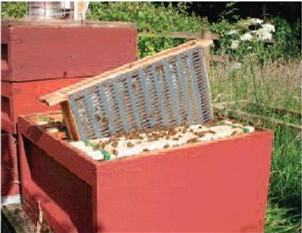IPM 5 Fighting Varroa : Biotechnical Tactics – Part 1
Colony management
Nutrition, stress, and other diseases
We had several diseases that killed our colonies before varroa, and they are still lurking out there. This has been the topic de jour with Colony Collapse Disorder ravaging apiaries nationwide. Beekeepers tend to blame varroa for every deadout, but in reality, other bad guys are often to blame. Don’t ignore AFB and EFB—persistent low levels can sap your colonies. Collapsing colonies in California frequently have high levels of nosema or tracheal mites. I’m not suggesting that varroa isn’t involved. Indeed, infestation by varroa puts a heck of a stress on individual bees, and the colony as a whole. Varroa hurts the colony, but it is usually other diseases, especially deformed wing virus (DWV) that finish it off. Surprisingly, Boecking, et al (2002), monitoring colonies in Germany, could not determine any correlation between varroa infestation levels and the clinical symptoms of sacbrood, chalkbrood, or Nosema. “High mite infestation did not lead to the appearance of these diseases” (their definition of “high mite infestation” was about 3000 mites). However, they did note that “a clear positive correlation was found between the presence of bees with deformed wings and the mite infestation level.” That is, when there’s a lot of mites, you tend to see deformed wings—likely from DWV going epidemic.
So what to do? Do all you can to minimize any additional stresses beyond varroa, since stressed bees tend to get sick. Maintain good domiciles for your bees–they do best in warm, dry boxes, and keep them in warm, sunny yards with good air drainage. Keep an eye on failing colonies, and prevent them from being robbed out. If you have doubts about the tracheal mite or nosema infestation levels of your colonies, have them tested. On the West Coast, Alan Butterfield (661-978-8290), or Jan Dormaier (509-639-2577) do testing for a fee. I recently had my own bees (200 bee minimum sample taken from all yards) tested by Alan. For $50, he sent me a report of varroa, tracheal, and nosema levels. At the cost of feeding Fumidil, or losing a single colony going into pollination, $50 is a bargain!
Most importantly, make sure your bees get good nutrition. Nothing beats a good mixed pollen flow. Pollen-starved colonies are stressed in many ways, nutritionally and immunologically, and can’t rear healthy, “fat,” long-lived winter bees. I can’t overestimate the importance of good summer pasture. Lack of good pasture leads to colony stress, robbing, and collapse. Read Andy Nachbaur’s wisdom at www.beesource.com/pov/andy/sad_bad.htm. If your bees can’t get enough natural pollen and nectar, you may need to move them, or give them supplemental feeding. Here in bone-dry California, it really makes a difference to feed in late summer and fall. Pollen supplements are a contentious topic, and I don’t want to step on toes. That said, I personally have great success with brewers yeast mixed with natural pollen (at least 10%) and sugar syrup. Be aware, however, that late summer feeding may ramp up mite reproduction—you may need to take additional mite control measures. Beekeepers may soon be adding probiotics (beneficial bacteria) to our supplements to improve survival and weight gain (Kaznowski, et al. 2005).
For a real eye opener, Google “epigenetics” (Watters 2006). Nutrition and stress events affect how our cells express the instructions in our DNA. Not only that, but nutrition or stress on the parent can affect the behavior and disease resistance of its offspring–sometimes for several generations! Think about the effects that drought, disease, mites, and miticides might have on the following generations of bees!
Bottom line: keep your bees well fed, and suppress other diseases.
Comb management
In nature, bees seldom use the same brood combs for very many years. Colonies either expand onto new combs, swarm and build new combs, or have old combs destroyed by wax moth. When beekeepers reuse the same old black rubbery-hard brood combs for many years, the combs become a repository of spores for chalkbrood, nosema, AFB (Berry & Delaplane 2001), EFB (Waite, et al. 2003), and viruses (Chen 2006). The beeswax also acts as a veritable sink for chemical contaminants from outside the hive (Smith & Wilcox 1990), and miticides applied inside the hive.
Berry and Delaplane compared colony development on new combs vs. old combs. They state: “The trend was for higher ending bee populations in new comb…” and “The bulk of the evidence suggests that new combs optimize overall honey bee colony health and reproduction. These findings suggest that beekeepers should eliminate very old brood combs from their operations.” This is a common practice in Europe to minimize diseases. Ringel (2002) also found that colonies on new combs produced slightly more brood than those on old combs. Surprisingly, though, in autumn, colonies in his study with new combs had twice the varroa infestation as those on old combs. This finding appears to be an anomaly. Clearly, we need to see more replications.
For a very different reason, some U.S. commercial beekeepers are trashing thousands of old combs that they suspect have become too miticide-contaminated to support healthy colonies. I’ll discuss the ramifications of miticide-contaminated combs in a subsequent article.
There is yet another reason to rotate out old combs, and that is to minimize the amount of drone cells, since drone brood is a literal varroa nursery. I will cover this aspect in detail in the next article in this series.
Bottom line: most studies have found it to be beneficial to cull older combs from your apiary.

An old comb that should be junked. The patch of drone brood would be a varroa breeding ground!
Small Cell Foundation
If you’ve surfed the Net about “organic” beekeeping, you’ve likely come across the topic of small cell (4.9 mm) foundation. Commercial beekeepers Ed (recently deceased) and Dee Lusby in Arizona have been keeping bees without any miticides or artificial feeding for a number of years. Dee attributes their success largely to using wax foundation pressed with a smaller cell size than the “standard” foundation offered in bee supply catalogs.
I do not wish to digress into the topic of “organic” beekeeping, but the possibility that small cell foundation may allow bees to handle the varroa mite is potentially of great import. Dee is an earnest and very helpful true believer in small cell, and a keen observer and researcher of bees. If you are interested, the following sites will direct you to Dee’s writings: http://www.beesource.com/pov/lusby/therm_map.htm, http://www.beesource.com/pov/lusby/part8.htm, http://www.beesource.com/pov/lusby/index.htm, and http://www.beesource.com/pov/lusby/part8.htm. The last site discusses “regression,” the tricky process of getting the bees to accept the smaller foundation.
Another take on small cell is offered by Dennis Murrell of Wyoming. Dennis was a long time commercial beekeeper, who has researched alternative forms of beekeeping. I found his web pages on small cell to be quite thought provoking: (Broken Link!) http://bwrangler.farvista.net/sxpe.htm (read all the subsections under “Small Cell” in order). I’m especially intrigued by his concept of a foundation graded from large to small cells. Dennis suggests that varroa can be managed by simply placing several small cell combs in the center of the broodnest.
I have zero experience with small cell myself. I’ve scoured the literature for controlled trials that tested small cell for mite control–the few I’ve found are largely inconclusive. Small cell beekeepers often practice ancillary mite control techniques that make it difficult to discern the actual degree of control due to cell size alone. Nevertheless, Dee has quite a following of “small cell” and “organic” beekeepers. Feelings about small cell can run strong in Internet discussions, and I am again not eager to step on anyone’s toes. Allow me to quote Bee-L moderator Aaron Morris (by permission):
“Claims of small cell have been made, repeatedly. Some adamant proponents have asserted that small cell will resolve everything from Varroa problems to brood diseases and return beekeeping to the glory days of our grandfathers when all one needed to do was put a hive of bees out in the spring and harvest copious amounts of honey in the fall…. On the other side are those who don’t buy the pitch… Regardless, there are many who point out that the small cell claims are unsubstantiated in the research circles, to which the advocates cry, we don’t need no stinkin’ verification at universities or bee labs, we know it works! The proof is in our apiaries! No matter how often it is said, no matter how loudly it is said, it remains without a doubt that small cell claims are unsubstantiated in accredited research circles.”
That said, there are some upcoming trials of small cell by commercial beekeepers. They will be watched closely, and I’m sure the results will be reported in this journal. If you are curious to experiment yourself, beeswax 4.9mm small cell foundation is offered in some of the catalogs. Surprisingly, the Mann Lake PF-100 plastic frame cell size measures 5.0mm—a suggested size for “first regression.” Although it may seem surprising that the slightly larger size (by approximately the diameter of a human hair) would make a difference, small cell advocates claim that it does! I would be delighted should small cell prove to be an effective tool to add to our arsenal against the mite. However, I’m a hard data kind of guy, and until I see confirmation of its efficacy in controlled trials, I cannot recommend for or against small cell.
Bottom line: small cell is an appealing premise, but remains to be substantiated by controlled trials. Update: See HoneySuperCell trial.
Update 1/26/2010
Since I wrote the above article, there have been a number of other papers (Berry, Ellis, Taylor, etc) that have debunked the advantage of small cell.
One shortcoming of most of these trials, other than Ellis’ (2009a Exp Appl Acarol 47:311–316), is that they did not run for a full year. According to some small cell proponents (Dee Lusby, pers comm), the beneficial effect of small cell is most noticeable when the colony starts to ramp down in late summer (typically in early September).
This wouldn’t apply in the case of Ellis’ trial, since in Florida, mite population levels follow a different pattern (see Ellis 2009b JAR 48(1): 72-76). However, note in that in Ellis (2009a) that mite levels in small cell were often different than that in large cell. In Florida, it is common for mite levels to peak in May (Ellis, pers comm), which means that to truly evaluate that trial, it should have been run until perhaps July of the second season. Unfortunately, it ran only until May.
So, the small cell folk could say about Ellis’ trial that the mites in the brood in May would have soon been killed by the bees. Note that in the second May counts, the small cell colonies had more adult bees, lower mite levels on those bees, and that most of the mites were in the brood at that time.
Another issue is that mite resistant bees tend to display varroa sensitive hygiene more as mite levels increase. So in Ellis’ trial, the bees may have ignored the low mite levels in the first May.
What is needed is a two-season controlled trial of small cell vs. regular cell in the same yard. Such a trial was actually performed by Dr. Ingemar Fries in Sweden (Fries, I. 2004. Cellstorlek och varroakvalster. Bitidningen 103, mars , 18-20). He did not find any difference in mite levels between the two treatments. I have heard criticism that there might have been mite drift from the regular cell to small cell colonies–I have to discount that criticism out of hand, since I personally often see colonies maintaining very low mite levels, even when set next to colonies collapsing from high mite levels.
As far as my HoneySuperCell trial, please refer to the update of that article. Although the combs appear to help control mites, I cannot say if the mechanism has anything to do with cell size. I’m waiting for more detailed research from others.
There also appears to be little evidence that 4.9 mm cell is more “natural” for bees in temperate climates. However, bees on natural combs do build a range of cell sizes, often with smaller cells (down to 4.8 mm) in the center of the combs. So I cannot discount the effect of cell size out of hand.
An compelling reason to be skeptical of small cell is the observation that mite reproduction was not inhibited in the natural small cell combs of A. m. scutellata colonies when the mite arrived in South Africa (Allsopp 2006). Ditto for the scattered colony population of A. m. mellifera on Santa Cruz Island when Wenner introduced mites–which promptly killed all the colonies, despite them all existing on natural cell combs. Ditto for the collapse of feral colonies on natural combs (typically containing small cells near the center) nearly everywhere on Earth when varroa was introduced!
A recent presentation by Dr. Maryanne Frazier showed that varroa has spread widely throughout Africa in both the managed and feral population (there really isn’t any difference). Natural small cell did not stop the spread. However, both African and Africanized bee populations, due to an apparent preadaptation against parasites, a shorter development time, strong grooming behavior, and varroa sensitive hygiene are, after a short period of evolution, generally able to keep mites at tolerable levels. This also appears to be the case in Arizona, where the local Africanized bees used by Dee Lusby keep mites under control. I spoke with beekeeper Fred Terry in Tucson, who proudly keeps AHB–he says that they control mites just fine whether they are kept on small or regular cell.
So in summary, there are a number of studies that demonstrate clearly that in the short term mites reproduce just fine in small cell, so any effect of small cell would not be directly due to reducing the ability of mites to reproduce (indeed, in some trials they reproduced at a higher rate in small cell!). Dr. Zachary Huang (2001) found that mites actually had a higher reproductive rate in natural worker-size cells than naturally-laid worker eggs in natural drone-size cells, for both Apis mellifera and A cerana! This hard data makes me rather skeptical of small cell claims.
If small, or “natural” cell sizing had an appreciable effect upon varroa tolerance, one would think that it would have been evident in the non-managed populations!
Small cell is generally used by small-scale beekeepers, and they may attribute their success to small cell. However, many small scale beekeepers are keeping healthy colonies without miticides these days whether they use small cell or not. This is an important point, since few run controls to see if there success is due to small cell or not.
Bottom line: I would really love it if something as simple as cell size could be used to control varroa. However, after carefully reviewing the evidence, I am not convinced that small cell is an effective varroa control mechanism.
Brood and Queen Manipulation
A note on biotechnical techniques involving colony manipulation: keep it minimal! The fewer disturbances to the colony, the better. Cool-weather manipulation can exacerbate nosema infestations; warm weather disruption can decrease production. Perform your manipulations quickly, and with the least amount of smoke and disruption to the colony. It’s counterproductive to knock back the mites if you kill the queen or stress the colony in the process!
Making Splits
Any break in broodrearing during spring or summer periods will set the mite growth curve back. Nucs made up with queen cells suffer about a two-week break in egg laying. Colonies grown from nucs will often not require treatment until the next season. Another trick I’ve tried is to treat nucs a week after the queen begins laying. During a very narrow window of about a day, the nuc will have zero to very little brood in which mites can hide. A “flash” treatment with some sort of miticide, or a few powdered sugar dustings, at that time can effectively kill most of the mites, since they are all by necessity phoretic.

Two summer nucs in a split box. In areas with late summer flows (and drones), weak nucs can be made up in August, the queens evaluated as they build up, then are wintered either wrapped, or on top of a strong colony. The nucs give you two relatively mite-free colonies in spring. This method is used successfully in Vermont by Kirk Webster and Mike Palmer, who provided me this photograph.
Restriction of Queen Laying
This is too time consuming for the commercial beekeeper, but could be used very effectively by the hobbyist. Similar to the nucs above, if the queen is caged to restrict her from laying eggs for 15 days, then released, the colony will contain only phoretic mites at day 21 from the original caging. Treat at that time.
Even more effective (and chemical free) would be to cage the queen (on Day 0) in a cage made of queen excluder material that holds two drone combs. Allow her to lay for 15 days, then release her. Remove the drone combs on Day 24—they will contain the vast majority of the mites. Similar methods have been proven to trap up to 96% of the mites (Calis, et al. 1999)! This method could conceivably be integrated with requeening.

By restricting the queen’s egglaying to drone combs for a short period, the beekeeper can eliminate up to 96% of varroa mites from a colony. This is accomplished by confining the queen temporarily on a special comb covered with queen excluder material. © Crown copyright from Managing Varroa
There are proven methods of comb swapping and queen restriction that also work to totally eliminate chemical control. They are too complex for me to recommend. See http://www.xs4all.nl/~jtemp/dronemethod.html, or p. 14 of Managing Varroa.
Bottom line: making treated splits knocks back the mite; restricting the queen works, but is labor intensive.



